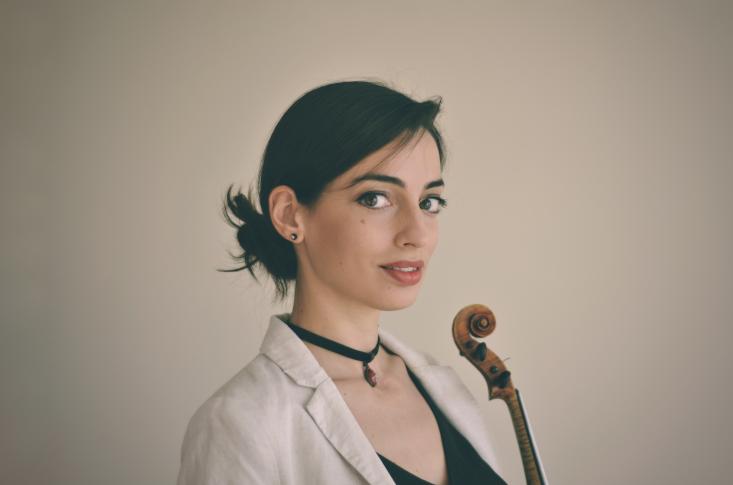Between east and west: about Ali Ufki and not only [a conversation with Ceren Türkmenoğlu]
Ceren Türkmenoğlu is a Turkish violinist, multi-instrumentalist and composer. She was educated in her native Ankara, then in Germany, in Leipzig. In 2017, she moved to Boston to complete her studies and obtain a master's degree. Two years in a row, she was a scholarship holder of the Boston Foundation in her own project "Music from where the Sun Rises", in which she researched Ottoman-Turkish classical music from a historical perspective. She has now returned to the position of a violinist in the Ankara Opera and Ballet Orchestra, and is also working on her own music. In July, her first album Mâî was released, containing arrangements and her own compositions.
And who was Ali Ufki? Who wants to know it, we invite you to the interview.
Władysław Rokiciński: In the European tradition, the term "early music" is used in relation to the music composed and performed during the Middle Ages and the Renaissance period. Sometimes it is applied also for the music of the Baroque period. And how is it in Turkey? Do you use the same or similar term for the music composed and performed in the past?
Ceren Türkmenoğlu: The classical music composed in the past is not specifically named as “early music” in Turkey. Rather, it is referred to as Ottoman Music or Turkish Classical Music, regardless of the period. Turkish Art Music is also a term used for this style; however it is more associated with the works that are composed after the Republic, while the former ones represent the music composed during the Ottoman era.
Although Ottoman/Turkish classical music is a style that primarily relies on oral tradition, thanks to the notation and documentation of the musical works throughout history, many pieces of music were able to survive to this day. I would like to mention a few key figures in this subject.
Ali Ufki, (1610? – 1675?) whom I will speak in detail later, preserved hundreds of classical Ottoman songs and instrumental pieces by notating them in western staff notation. This was the first instance in which western staff notation was applied to the Turkish music.
Dimitrie Cantemir, (1673 – 1723 ), a Romanian musician, historian, and scholar who was the prince of Bogdan (this is how Moldavia was referred to in Ottoman Turkish), helped preserve numerous traditional pieces by publishing them in a musical notation he developed.
Another important figure, Hampartsum Limondjian (1768 – 1839), an Ottoman Armenian musician, developed the "Hampartsum" notation system, which became the main notation system for Ottoman classical music until the 20th century. Using his own system, Hampartsum transcribed most of 18th century Turkish music compositions. It remained as the dominant notation for nearly two hundred years and was used by many in the transcription of thousands of pieces of music.
On this note, it is worth mentioning that although the music style is commonly named as Turkish Classical Music today, one should acknowledge that it involves the invaluable contribution of the Greek, Armenian, Jewish and European musicians as well.
Is it possible in easy words - in words addressed to non-specialists – and as briefly as possible, to state the essential difference between the early music from Ottoman Turkey and the countries of Christian Europe?
I would say the most essential difference is the tuning system between the two music styles. To say it in simple words, Turkish music is microtonal as opposed to European music. For instance, in European music one whole step (the distance between, say, G (sol) to A (la)) consists of 2 half steps. There is nothing in between. However, in Turkish music one whole step divides into 9 equal intervals, which are called commas. Based on the makam (mode/scale) of the piece different microtones are used within a context.
Makam is the scale in Turkish music; however, the structure is different from the Western scale. It consists of tetrachords and pentachords, and what determines the makam is not only the accidentals that are in the scale, but the melodic progression that specific makam exhibits. There have been as many as 600 makams that have been used so far, with around 20 of them being more common.
After the differences, I’d like to point out a similarity as well. The two music styles have similarities to each other in terms of improvisation. In Western early music, improvisation was an important component of performance and the mastery of a musician would be measured by their improvisation skill as well as virtuosity on the instrument. This applies to the Ottoman music as well, where improvisation is a powerful element in music-making.
In the European Christian countries – and especially, I think, in the Roman Catholic ones – the Church was a patron and addressee of the composed music, and the interiors of churches often served as concert halls. It couldn’t be like that in Turkey, I think?
In the Ottoman Empire, the palace was the patron and also the school of classical music. The Enderun, palace school, was an important institution as far as musical life in the court was concerned. In addition to the musicians trained within the palace, musicians trained outside were also given permanent employment at court or invited to take part in musical activities. Moreover, many sultans were composers and musicians themselves.
As the equivalent of churches serving as concert halls, instrument playing in the mosque was, and still is not welcome. Only recitation of Quran is permitted inside the mosques, which incorporates makam and therefore is musical. Also, the call for prayer, which is recited five times a day from the mosques, is recited in specific makams.
However in Sufism, both instrumental and vocal music plays a key role in the rituals that are held in the Sufi lodges. Moreover, the great Sufi mystic Mevlânâ, who is known as Rumi in the West, is claimed to have played the ney (reed flute) and the rebab (a bowed string instrument), the instruments that are specifically associated with Sufism.
That being said, it is important to underline that Turkey has hosted different beliefs and religions alongside Islam throughout history. Both in the Ottoman Empire and now in modern day Turkey, rituals and music events took and continue to take place also in the churches and synagogues.
And nowadays, is the performance of early music popular in Turkey? Are there many musicians and bands that perform it?
Performances of Ottoman/Turkish classical music still continue in Turkey today, however its popularity decreases with newer generations. As popular mainstream music styles dominate the scene, appreciation and knowledge of early Ottoman/Turkish music get limited to fewer people.
Nevertheless, there are many musicians and bands that perform this type of music and they are dedicated to preserving it. Moreover, there are music schools and conservatories that specialize in Turkish classical music education that also cover the earlier repertoire of the genre.
When it comes to performance, with the change of times and influence of Western music, some musicians develop new approaches in their performances of Ottoman/Turkish classical music. Applying Western concepts to the performance can be one of those approaches, but it can be tricky. Some people regard the Westernization of Ottoman/Turkish classical music as a kind of corruption. This might be, for instance, harmonizing the pieces (which doesn’t always work with makam music due to its microtonal nature), or arranging them for Western music orchestras (thus replacing the timbres of traditional instruments with Western ones and also performing with much larger groups). Some people strongly oppose such approaches and argue that this conflicts with the essence of the music. On the other hand, some people conduct successful cross-over projects and collaborations, creating a space that brings East and West together. I find that this is a very delicate issue and when done with taste and a holistic understanding of both music styles, it results in beautiful works, as long as the music doesn’t get detached from its roots and lose its identity.
Who was Ali Ufki?
Ali Ufki, whose birth name was Wojciech Bobowski, was a Polish man who spent many years of his life in Istanbul (then Constantinople) and made invaluable contributions to the culture and politics of the Ottoman Empire.
He was born in 1610 in Bobowa, near Gorlice. He was raised in a Protestant family and had started a career as a church musician. Around the age of 18, he was captured as a prisoner in a war and was brought to Istanbul.
Because of his music training he was sold to the court of Sultan Murat IV. In the palace he received education in the Enderun, the palace school. The Enderun primarily recruited students via devshirme system, where Christian children were receiving education and were converted to Islam.
After his education in the Enderun he was taken into the palace where he served as a musician, treasurer and interpreter. He was an important figure in the Ottoman state. He extraordinarily spoke 17 languages, among which were Turkish, Arabic, Farsi, Hebrew, German, Greek, Spanish, Italian and Latin, next to Polish.
He produced so many great works that astonishes one by the variety of his masterful skills. He translated the Bible into Ottoman Turkish, which for long served as the only complete one. He translated the Psalter into Ottoman Turkish and composed music for them in Ottoman music style. He wrote a grammar book of the Ottoman Turkish language, wrote poems in Turkish. The music he composed are considered among the most important in 17th century Ottoman music. Furthermore, he released two manuscript anthologies of Ottoman music, known as Mecmûa-i Sâz ü Söz (Collection of Instrumental and Vocal Works), thus helped those musical works survive to this day.
He did not enter Turkey voluntarily; he was taken as a prisoner. The times were like that. And yet he achieved a very high position in the political and cultural life of the Ottoman Empire. Did such careers – of people of not only Polish origin, of course - happen often then?
It did happen often. One of the reasons for this was the devshirme system that I mentioned above, where the Christian children would be taken into the Enderun, palace school, and receive education on various fields such as religion, literature, poetry, music, arts, languages, mathematics, geography, strategy and so on. They would also be educated on the Ottoman bureaucracy and some would later serve in the state, which was the case with Ali Ufki.
Another notable figure as an example to this would be Architect Sinan (1490-1588). He was born in the Ottoman Empire and had either Armenian, Greek, Albanian or Christian Turk origins, as there are different views on this. Sinan was taken into the Ottoman service under the devshirme system and was sent to Constantinople to be trained as an officer of the Janissary Corps. He later became the greatest architect of the classical period of Ottoman architecture, with the construction of more than 300 major structures and many other smaller projects.
Still, being trained in the palace school was not the only way how non-Muslims would be granted important ranks in the Empire. Sometimes people with distinguished skills would also reach up to these points with their accomplishments.
Coming back to music, what would you say about the music composed by Ali Ufki, having his epoch as a background?
I find his music exquisite as it is a perfect meeting point of Western music and Ottoman music. His compositions carry both Western and Eastern influences. A good example to this instance is the piece I performed and provided on the YouTube link, which is called “Semâî Efrencî”. Semai is an instrumental form which is similar to the rondo form in Western music. It typically consists of 4 sections, called hane, and each one would be followed by a teslim (refrain). Efrencî, on the other hand, means “European”. It is the perfect melting pot as Ali Ufki composed an Ottoman “semai” in makam “Nishabur”, which is in European style.
I arranged and recorded this piece in my home studio during the ongoing coronavirus lockdown in Turkey. Therefore all the instruments are played by myself. The manuscript of this piece is particularly intriguing, which I’d like to share with you. Notice how Ali Ufki notated the piece from right to left, as this was the writing direction of Ottoman-Turkish while the Arabic alphabet was in use:

The artist has her own website, to which she invites everyone interested in her work: https://www.cerenturkmenoglu.com/


